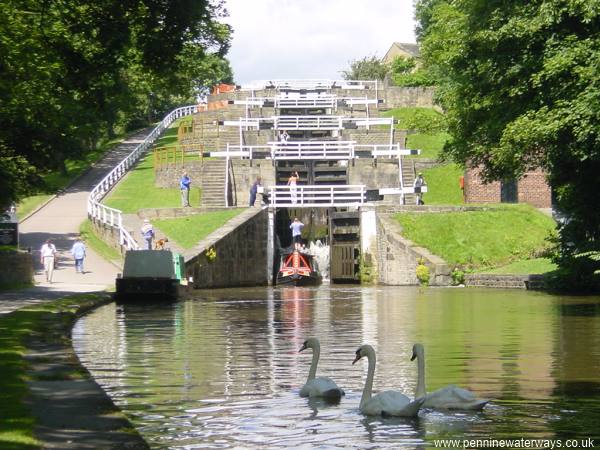The Leeds and Liverpool Canal was the first of the Trans-Pennine canals to be started and the last to be completed. The length and the complexity of the route meant that the canal took 46 years to build at a cost of five times the original budget.
The canal originates from a proposal in 1765 to construct a canal from Preston to Leeds to carry woollen goods from Leeds and Bradford and limestone from Skipton. Prospective backers in Lancashire argued for the canal to start from Liverpool.
The Canal Act passed in 1770 was for a route from Liverpool to Leeds via Parbold, Walton-le-Dale (just south of Preston), Colne and Skipton, with a branch from Burscough towards the River Ribble, a branch from Parbold to Wigan, a great aqueduct at Whalley and a branch from Shipley to Bradford.
In 1773, the first part to open was the lock-free section from Skipton to Bingley. In 1777, the canal was open between Liverpool, Parbold and Gathurst, near Wigan, and from Leeds to Gargrave, including the branch to Bradford. However, at this point all the funds had been spent and work came to a halt. By 1781 enough money was found to complete the branch to Wigan and the branch to Rufford.
It was ten years later, in 1791, that work re-started on building the canal west from Gargrave. In 1794 a new Act was passed, changing the route to run via Burnley and Blackburn instead of Whalley and Walton-le-Dale. Foulridge Tunnel was opened in 1796 making the canal navigable from Leeds to Burnley. The section from Burnley to Blackburn took a further 14 years to construct and the missing link west of Blackburn to the Lancaster Canal at Johnson's Hillock was not complete until six years later in 1816.
The plan to continue the canal as planned from Johnson's Hillock to Parbold was abandoned through lack of money. An arrangement was made to use the section of the Lancaster Canal between Johnson's Hillock and Wigan, and to incorporate that and the Wigan "branch" into the main line of the canal. It was not until 1816 that the through route opened between Liverpool and Leeds.
In 1818 the new branch was opened between Wigan and Bridgewater Canal at Leigh, linking with the rest of the canal system. In 1864 the Leeds and Liverpool Canal took over the southern section of the Lancaster Canal between Johnson's Hillock and Wigan Locks.
The engineering of the canal is very different from other Trans-Pennine canals. Most of the locks are concentrated in groups with long level sections between. Tunnels and cuttings are avoided where possible with the canal following the contours round bends and loops. In some sections the distance between points by canal is twice the shortest distance. The earliest locks, between Leeds and Bingley, are often grouped together to form staircases of two or three locks. The most spectacular feature of the canal is the five rise lock staircase at Bingley.

Bingley 5-rise lock staircase.
The canal prospered through the nineteenth century and was used for carrying stone, coal and many other goods. The impact of the railway age was not as great as with other canals but the coming of the lorry finally saw commercial traffic on the Leeds and Liverpool dwindling. The Bradford Canal closed in 1922 but commercial traffic continued along the main canal until 1964. Regular work stopped in 1972 when the movement of coal to Wigan Power Station ceased.
Through the later part of the twentieth century, the leisure potential of the canal began to be appreciated and boatyards, marinas and boat hire companies have developed along the canal which is now very popular with boaters, partly for its stunning scenery and partly for the long lock-free sections that are ideal for cruising.